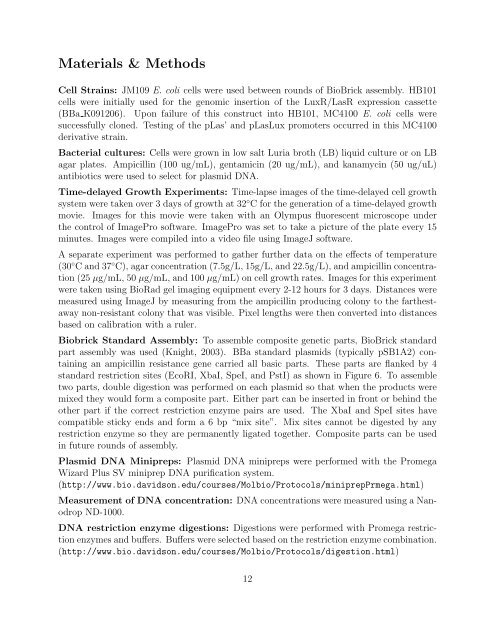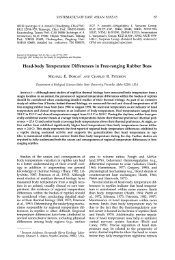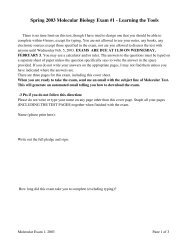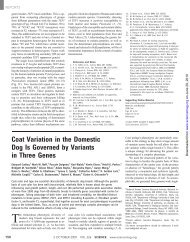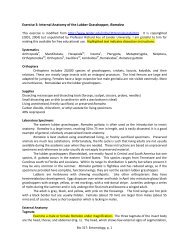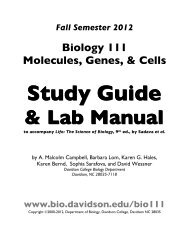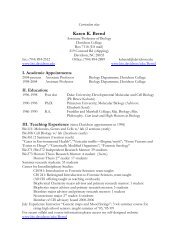Davidson College Department of Biology Honors Thesis Title ...
Davidson College Department of Biology Honors Thesis Title ...
Davidson College Department of Biology Honors Thesis Title ...
You also want an ePaper? Increase the reach of your titles
YUMPU automatically turns print PDFs into web optimized ePapers that Google loves.
Materials & Methods<br />
Cell Strains: JM109 E. coli cells were used between rounds <strong>of</strong> BioBrick assembly. HB101<br />
cells were initially used for the genomic insertion <strong>of</strong> the LuxR/LasR expression cassette<br />
(BBa K091206). Upon failure <strong>of</strong> this construct into HB101, MC4100 E. coli cells were<br />
successfully cloned. Testing <strong>of</strong> the pLas’ and pLasLux promoters occurred in this MC4100<br />
derivative strain.<br />
Bacterial cultures: Cells were grown in low salt Luria broth (LB) liquid culture or on LB<br />
agar plates. Ampicillin (100 ug/mL), gentamicin (20 ug/mL), and kanamycin (50 ug/uL)<br />
antibiotics were used to select for plasmid DNA.<br />
Time-delayed Growth Experiments: Time-lapse images <strong>of</strong> the time-delayed cell growth<br />
system were taken over 3 days <strong>of</strong> growth at 32 ◦ C for the generation <strong>of</strong> a time-delayed growth<br />
movie. Images for this movie were taken with an Olympus fluorescent microscope under<br />
the control <strong>of</strong> ImagePro s<strong>of</strong>tware. ImagePro was set to take a picture <strong>of</strong> the plate every 15<br />
minutes. Images were compiled into a video file using ImageJ s<strong>of</strong>tware.<br />
A separate experiment was performed to gather further data on the effects <strong>of</strong> temperature<br />
(30 ◦ C and 37 ◦ C), agar concentration (7.5g/L, 15g/L, and 22.5g/L), and ampicillin concentration<br />
(25 µg/mL, 50 µg/mL, and 100 µg/mL) on cell growth rates. Images for this experiment<br />
were taken using BioRad gel imaging equipment every 2-12 hours for 3 days. Distances were<br />
measured using ImageJ by measuring from the ampicillin producing colony to the farthestaway<br />
non-resistant colony that was visible. Pixel lengths were then converted into distances<br />
based on calibration with a ruler.<br />
Biobrick Standard Assembly: To assemble composite genetic parts, BioBrick standard<br />
part assembly was used (Knight, 2003). BBa standard plasmids (typically pSB1A2) containing<br />
an ampicillin resistance gene carried all basic parts. These parts are flanked by 4<br />
standard restriction sites (EcoRI, XbaI, SpeI, and PstI) as shown in Figure 6. To assemble<br />
two parts, double digestion was performed on each plasmid so that when the products were<br />
mixed they would form a composite part. Either part can be inserted in front or behind the<br />
other part if the correct restriction enzyme pairs are used. The XbaI and SpeI sites have<br />
compatible sticky ends and form a 6 bp “mix site”. Mix sites cannot be digested by any<br />
restriction enzyme so they are permanently ligated together. Composite parts can be used<br />
in future rounds <strong>of</strong> assembly.<br />
Plasmid DNA Minipreps: Plasmid DNA minipreps were performed with the Promega<br />
Wizard Plus SV miniprep DNA purification system.<br />
(http://www.bio.davidson.edu/courses/Molbio/Protocols/miniprepPrmega.html)<br />
Measurement <strong>of</strong> DNA concentration: DNA concentrations were measured using a Nanodrop<br />
ND-1000.<br />
DNA restriction enzyme digestions: Digestions were performed with Promega restriction<br />
enzymes and buffers. Buffers were selected based on the restriction enzyme combination.<br />
(http://www.bio.davidson.edu/courses/Molbio/Protocols/digestion.html)<br />
12


